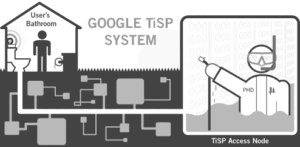
With the fast pace of technological change, one of the biggest problems has been the “last mile” problem. High-speed internet has little difficulty reaching a node that might be a mile away from your home or office. But that pesky “last mile” is the challenge. (For example our Westminster office is far enough from the phone company central office that DSL is not very fast.)
It’s not only Internet connectivity that suffers from the “last mile” problem. For package delivery, in desperation Fedex devised the misnamed Smartpost, a service in which Fedex hands off your package to the Postal Service for that last mile of delivery. And UPS devised the equally misnamed Surepost which works the same way.
So I was fascinated to be reminded of a “last mile” solution for internet access that Google proposed a few years ago, called TiSP. The idea was that you would drop a weighted fiber-optic cable down your sewer line and it would reach an internet node.
The idea of TiSP was to leverage the existing infrastructure of sewer lines. In this way a super-fast fiber-optic internet connection could be quickly and easily set up, with no need for the usual “last mile” trenching or other construction work to bring “fiber to the curb” or “fiber to the home”.
Alas, the TiSP program never fulfilled its promise and as of now in 2019 I am not aware of any home or office that is presently receiving Internet connectivity in this way.
Are you a user of TiSP? Did you by chance happen to notice the exact date that Google announced this program? If so, please post a comment below.

Was the original article date April 1st? Reading some of the information makes it sound to me like it probably was…
Actually…
https://archive.google.com/tisp/press.html
Date is April 1, 2007
You may wish to review Wikipedia’s list of Google April Fool’s pranks:
https://en.wikipedia.org/wiki/List_of_Google_April_Fools%27_Day_jokes